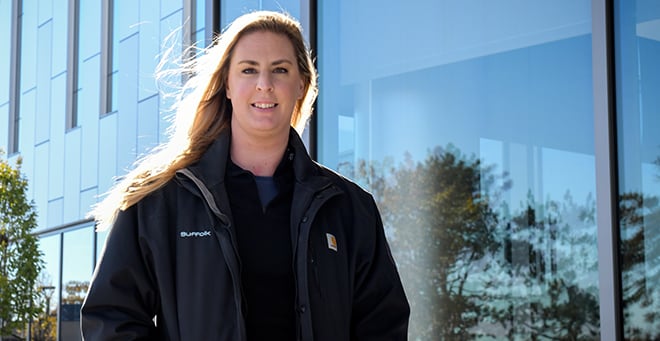UMass Chan Medical School exceeded diversity hiring goals in the construction of the newly completed community-based outpatient clinic (CBOC) for veterans on its Worcester campus, according to the University of Massachusetts Building Authority, general contractor Suffolk Construction and UMass Chan. The clinic is a partnership between UMass Chan and the VA Central Western Massachusetts Healthcare System.

The UMass Building Authority has workforce participation goals for projects; for the VA clinic, the workforce goals were 15.3 percent minority and 6.9 percent women with a combined M/W/VBE (minority, women and veteran business enterprises) goal of 10.4 percent for the construction of the CBOC.
“These goals are set to ensure the fair participation of diverse firms and create access to opportunity for a local and diverse workforce,” said Dara Frederick, trade partner diversity officer at Suffolk Construction.
The CBOC, which was officially unveiled at a ribbon-cutting ceremony on Monday, Nov. 8, was built with a workforce comprising 27.4 percent minorities and 8 percent women, and although not required, veterans comprised 5 percent of the project workforce. Suffolk exceeded the required 10.4 percent M/W/VBE participation goal with a total of 14 percent awarded contracts to M/W/VBE firms.
“Suffolk made diversity on this project a priority and found ways to meet and exceed expectations. We met with our trade partners months in advance to review their projected workforce and steered the conversation about diversity expectations,” said Frederick.
Suffolk also leveraged the relationship with its union and community partners. Its partnership with pre-apprenticeship programs such as Building Pathways and Youth Build supports the developing pipeline of workers for its trade partners and the future workforce of the building trades. When contractors are not able to meet the workforce requirement, Suffolk is able to connect them to the resources needed to obtain a qualified and local workforce, which helps them meet the goals, Frederick said.
“This process puts us ahead of the curve with our proactive approach to ensure diversity on the job site and making sure that our projects are a true reflection of the communities in which we build,” Frederick said. “While our process certainly helped in obtaining a diverse workforce on the CBOC, it is not without challenges. Our trade partners at times can more easily obtain a diverse workforce in certain trades, whereas in some trades they experience a shortage of minority and women workers. In achieving the M/W/VBE participation goals, we implemented a diversity strategy that outlined a commitment for our trades to engage the participation of M/W/VBE firms. This allowed us to hold our trade partners accountable and drive our success in achieving 14 percent M/W/VBE participation—beyond the goal of 10.4 percent. We know the barriers that small businesses face. It’s not that they can’t do the work, but they often don’t have the capacity. With these big bidding packages, we must ask how we can be intentional in creating opportunities at the capacity in which they can perform,” said Frederick.
The University of Massachusetts Building Authority Access to Opportunity Committee, which provides resources and assistance to contractors for meeting compliance goals, supported the CBOC project.
“This collaborative effort at achieving workforce diversity goals is of paramount importance for the University of Massachusetts Building Authority and demonstrates that there is a dedicated and talented labor supply of people of color and women who are ready and willing to become part of the workforce,” said Maggie Drouineaud, director of compliance at UMBA. “The University of Massachusetts Building Authority has long held that recruiting a construction workforce that reflects the regional population not only builds community support for capital investment, but it is also a smart business practice. The compliance results may look like statistics, but these statistics are people’s lives and the creation of opportunities for minority businesses, people of color and women.”
Fred Taylor, business representative, Carpenters Local 336, and president of the Worcester branch of the NAACP noted, “We are inspired that UMass has been intentional about both setting diversity goals regarding subcontractors and workforce on this project and working closely with Suffolk Construction to achieve those goals. This project, like many others, shows that diversity goals can not only be implemented but also accomplished for projects in Worcester.”
Allison Knoff, a project manager at Suffolk, has worked on the VA building from the start. Part of her job included qualifying companies to bid on aspects of the project, and then negotiating and awarding contracts to the myriad of subcontractors needed to build the building.
“In that process, we look at cost and capabilities of course, but workforce diversity is also a very important consideration,” Knoff said. “It’s much more than just a good faith effort. We do a lot of outreach with these companies to help increase the participation of women and minorities, which is the way it should be.”
Related stories on UMassMed News:
Veterans Affairs and UMass Chan celebrate ribbon cutting of new community outpatient clinic
Final beam of new VA clinic placed during UMass Medical School ceremony